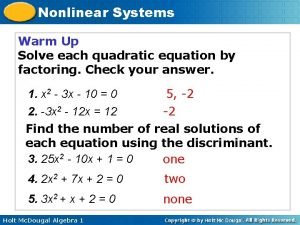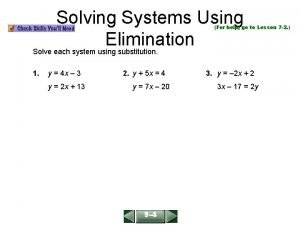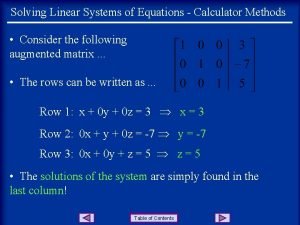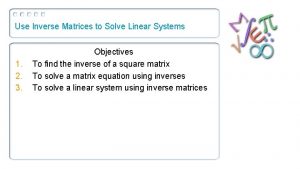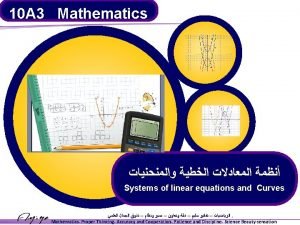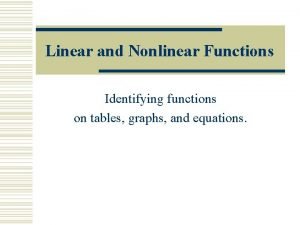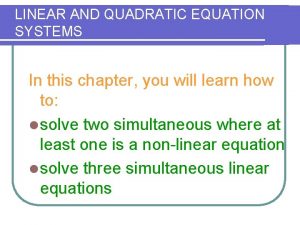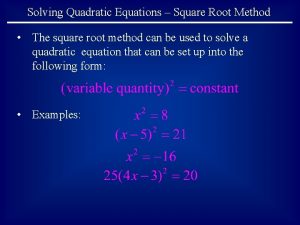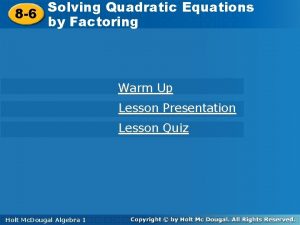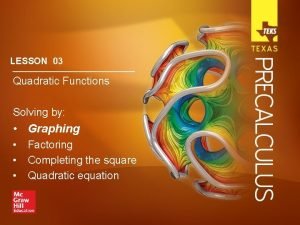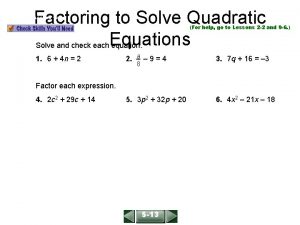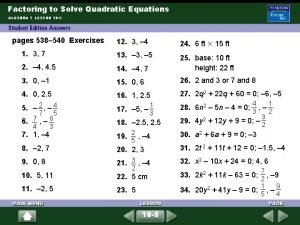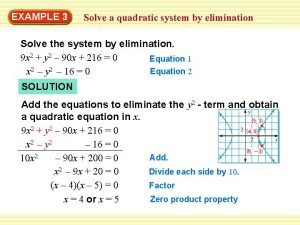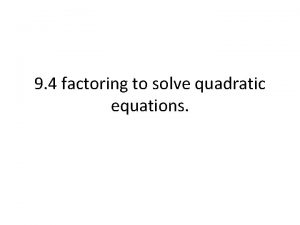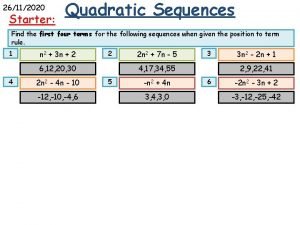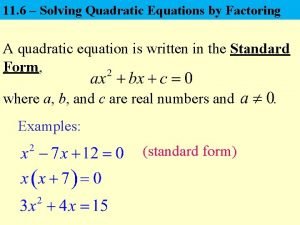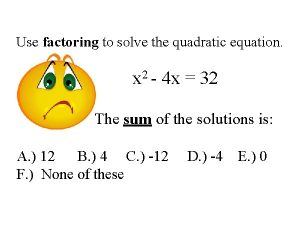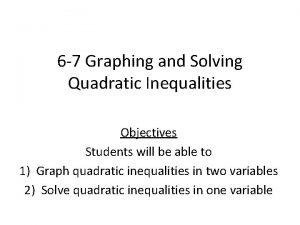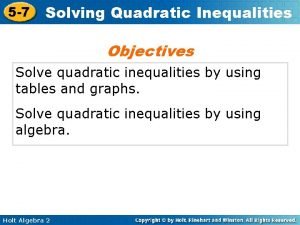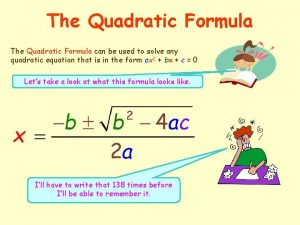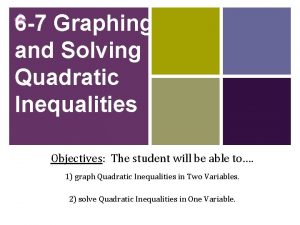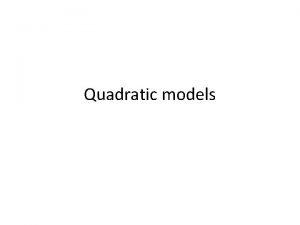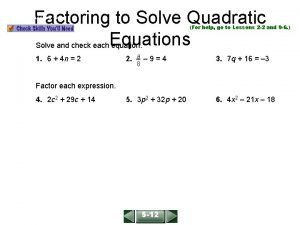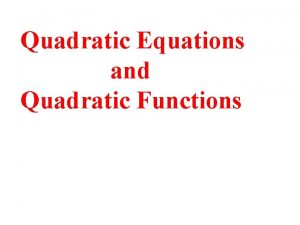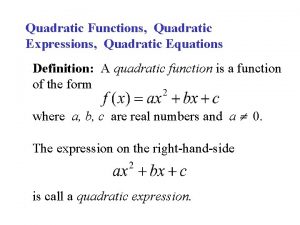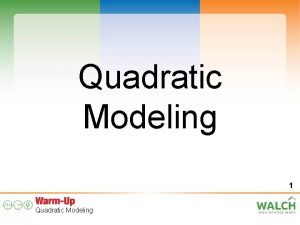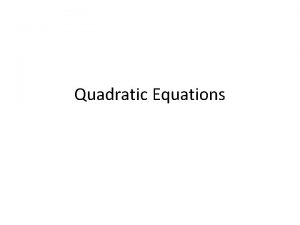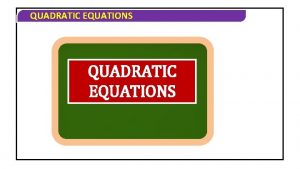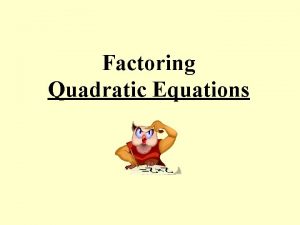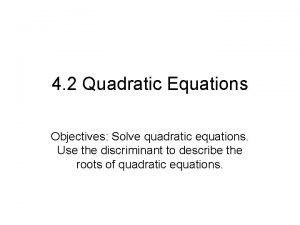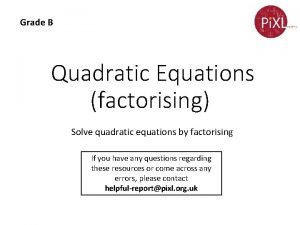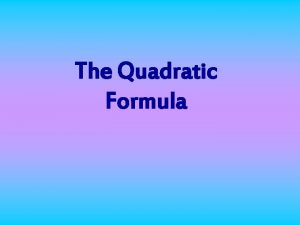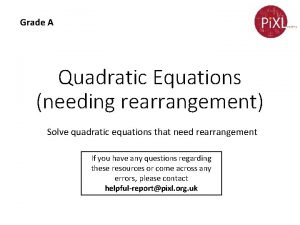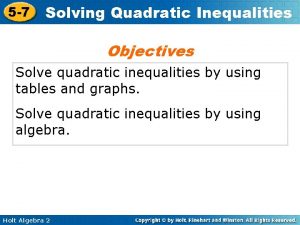Non linear system Warm Up Solve each quadratic







































- Slides: 39

Non linear system

Warm Up Solve each quadratic equation by factoring. Check your answer. 5, -2 -2 Find the number of real solutions of each equation using the discriminant. 3. 25 x 2 - 10 x + 1 = 0 one 1. x 2 - 3 x - 10 = 0 2. -3 x 2 - 12 x = 12 4. 2 x 2 + 7 x + 2 = 0 two 5. 3 x 2 + x + 2 = 0 none

Objectives Solve systems of equations in two variables in which one equation is linear and the other is quadratic.

Vocabulary nonlinear system of equations

Recall that a system of linear equations is a set of two or more linear equations. A solution of a system is an ordered pair that satisfies each equation in the system. Points where the graphs of the equations intersect represent solutions of the system. A nonlinear system of equations is a system in which at least one of the equations is nonlinear. For example, a system that contains one quadratic equation and one linear equation is a nonlinear system.

A system made up of a linear equation and a quadratic equation can have no solution, one solution, or two solutions, as shown below.

Remember! A quadratic function has the form y = ax 2 + bx + c. To graph a quadratic function, start by using x = to find the axis of symmetry and the vertex.

Example 1: Solving a Nonlinear System by Graphing Solve the system by graphing. Check your answer. y = x 2 + 4 x + 3 y=x+3 Step 1 Graph y = x 2 + 4 x + 3. The axis of symmetry is x = – 2. The vertex is (– 2, – 1). The y-intercept is 3. Another point is (– 1, 0).

Example 1: Continued Step 2 Graph y = x + 3. The slope is 1. The y-intercept is 3. Step 3 Find the points where the two graphs intersect. The solutions appear to be (– 3, 0) and (0, 3).

Example 1: Continued Check Substitute (– 3, 0) into the system. y = x 2 + 4 x + 3 0 (-3)2 + 4(-3) + 3 0 9 – 12 + 3 0 0 y=x+3 0 0 -3 + 3 0

Example 1: Continued Substitute (0, 3) into the system. y = x 2 + 4 x + 3 3 (0)2 + 4(0) + 3 3 0+0+3 3 3 y=x+3 3 3 0+3 3

Check It Out! Example 1 1. Solve the system by graphing. Check your answer. y = x 2 - 4 x + 5 y=x+1 Step 1 Graph y = x 2 – 4 x + 5. The axis of symmetry is x = 2. The vertex is (2, 1). The y-intercept is 5. Another point is (– 1, 10).

Check It Out! Example 1 Continued Step 2 Graph y = x + 1. The slope is 1. The y-intercept is 1. Step 3 Find the points where the two graphs intersect. The solutions appear to be (1, 2) and (4, 5). Check Substitute (1, 2) into the system.

Check It Out! Example 1 Continued y=x+1 y = x 2 - 4 x + 5 2 (1)2 - 4(1) + 5 2 1 -4+5 2 2 1+1 2 Substitute (4, 5) into the system. y = x 2 - 4 x + 5 5 (4)2 - 4(4) + 5 5 16 - 16 + 5 5 5 y=x+1 5 5 4+1 5

Remember! The substitution method is a good choice when either equation is solved for a variable, both equations are solved for the same variable, or a variable in either equation has a coefficient of 1 or -1.

Example 2: Solving a Nonlinear system by substitution. Solve the system by substitution. y = x 2 - x - 5 y = -3 x + 3 Both equations are solved for y, so substitute one expression for y into the other equation for y. -3 x + 3 = x 2 –x -5 Substitute -3 x = 3 for y in the first equation

Example 2: Continued 0 = x 2 + 2 x - 8 Subtract -3 x + 3 from both sides. 0 = (x + 4) (x – 2) Factor the trinomial. x + 4 = 0 or x – 2 = 0 Use the zero product property X = -4 x=2 Solve each equation Substitute x = – 4 into y = – 3 x + 3 to find the corresponding y-value.

Example 2: Continued y = – 3(– 4) + 3 y = 12 + 3 y = 15 One solution is (4, 15). Substitute x = 2 into y = – 3 x + 3 to find the corresponding y-value. y = – 3(2) + 3 y = – 6 + 3 y = – 3 The second solution is (2, – 3). The solutions are (4, 15) and (2, – 3).

Check It Out! Example 2 1. Solve the system by substitution. Check your answer. y = 3 x 2 - 3 x + 1 y = -3 x + 4 Both equations are solved for y, so substitute one expression for y into the other equation for y. -3 x + 4 = 3 x 2 - 3 x + 1 Subtract -3 x + 4 for y in first equation. 0 = 3 x 2 - 3 Subtract -3 x + 4 from both sides

Check It Out! Example 2 Continued 0 = 3(x 2 – 1) Factor out the GCF, 3. 0 = 3(x + 1)(x-1) Factor the binomial. x + 1 = 0 or x - 1 = 0 Use the Zero Product Property x = -1 Solve each equation x=1 Substitute x = – 1 into y = – 3 x + 4 to find the corresponding y-value.

Check It Out! Example 2 Continued y = – 3(– 1) + 4 y=3+4 y=7 One solution is (– 1, 7). Substitute x = 1 into y = – 3 x + 4 to find the corresponding y-value. y = – 3(1) + 4 y = – 3 + 4 y=1 The second solution is (1, 1). The solutions are ( – 1, 7) and (1, 1).

Example 3 : Solving a Nonlinear System by Elimination. Solve each system by elimination. A 3 x - y = 1 y = x 2 + 4 x - 7 Write the system to align the y-terms.

Example 3 : Continued 3 x – y = 1 y = x 2 + 4 x - 7 Add to eliminate y 3 x = x 2 + 4 x - 6 -3 x - 3 x Subtract 3 x from both side 0 = x 2 + x - 6 0 = (x + 3)(x – 2) Factor x + 3 = 0 or x – 2 = 0 Use the Zero Product Property

Example 3 : Continued x = -3 or Solve the equations x=2 Write one of the original equations y = x 2 + 4 x - 7 y =(-3)2 + 4(-3) - 7 y = (2)2 + 4(2) - 7 Substitute each xvalue and solve for y. y = -10 y=5 The solution is (– 3, – 10 ) and (2, 5).

Example 3 : Continued B y = 2 x 2 + x - 1 x - 2 y = 6 Write the system to align the y-terms. y = 2 x 2 + x + 1 x - 2 y = 6 2(y) = 2(2 x 2 + x + 1) x - 2 y = 6 Multiply the equation by 2 2 y = 4 x 2 + 2 x + 2 x - 2 y = 6 Add to eliminate y

Example 3 : Continued x = 4 x 2 + 2 x + 8 0 = 4 x 2 + x + 8 Subtract x from both side Solve by using the quadratic formula - b ± √b 2 – 4 ac x= 2 a - 1 ± √ 12 – 4(1)(8) x= 2(4) - 1 ± √– 31 x= 8 Since the discriminant is negative, there are no real solutions

Check It Out! Example 3 1. Solve each system by elimination. Check your answers. . a 2 x - y = 2 y = x 2 - 5 Write the system to align the y-terms 2 x - y = 2 y = x 2 - 5 2 x = x 2 - 3 -2 x Add to eliminate y Subtract 2 x from booth sides

Check It Out! Example 3 Continued 0 = x 2 – 2 x - 3 0 = (x-3) (x+1) Factor. x-3 = 0 or x+1 = 0 Use the Zero Product Property x = 3 or x = -1 Solve the equation y = x 2 - 5 Write one of the original equations y = (3)2 - 5 y = (-1)2 - 5 Substitute each xvalue and solve for y.

Check It Out! Example 3 Continued y=4 y = -4 The solution is (3, 4) and (– 1, – 4). b y = x 2 - 2 x - 5 5 x - 2 y = 5 Write the system to align the y-terms

Check It Out! Example 3 Continued y = x 2 - 2 x - 5 5 x - 2 y = 5 2(y) = 2(x 2 - 2 x – 5) 5 x - 2 y = 5 Multiply the equation by 2 2 y = 2 x 2 - 4 x - 10 5 x - 2 y = 5 Add to eliminate y 5 x = 2 x 2 - 4 x - 5 0 = 2 x 2 - 9 x - 5 Subtract 5 x from booth sides

Check It Out! Example 3 Continued 0 = (2 x + 1) (x – 5) Factor the trinomial x = - 0. 5 Solve the equations. or y = x 2 - 2 x - 5 x=5 y = x 2 - 2 x - 5 y = (-0. 5)2 – 2(-0. 5) - 5 Write one of the original equations y = (5)2 – 2(5) - 5 Substitute each xvalue and solve for y. y = -3. 75 y = 10 The solution is (– 0. 5, – 3. 75) and (5, 10).

Remember! The elimination method is a good choice when both equations have the same variable term with the same or opposite coefficients or when a variable term in one equation is a multiple of the corresponding variable term in the other equation.

Example 4: Physics Application The increasing enrollment at South Ridge High School can be modeled by the equation E(t) = -t 2 + 25 t + 600, where t represents the number of years after 2010. The increasing enrollment at Alta Vista High School can be modeled by the equation E(t) = 24 t + 570. In what year will the enrollments at the two schools be equal? Solve by substitution 24 t + 570 = -t 2 + 25 t + 600 0 = -t 2 + t + 30 Substitute 24 t + 570 for E(t) in the first equation. Subtract 24 t + 570 from the both sides.

Example 4: Continued 0 = -1( t – 6) ( t + 5) Factor the trinomial. t-6=0 Use the Zero Product Property. t =6 or or t+5=0 t = -5 Solve the each equation. In 6 years, or 2016, the enrollments at the two schools will be equal.

Helpful Hint When t = 0, the ball and elevator are at the same height because they are both at ground level.

Check It Out! Example 4 An elevator is rising at a constant rate of 8 feet per second. Its height in feet after t seconds is given by h = 8 t. At the instant the elevator is at ground level, a ball is dropped from a height of 120 feet. The height in feet of the ball after t seconds is given by h = -16 t 2 + 120. Find the time it takes for the ball and the elevator to reach the same height. Solve by substitution. 8 t = -16 t 2 + 120 Substitute 8 t for h in the first equation. 0 = -16 t 2 -8 t + 120 Subtract 8 t from both side

Check It Out! Example 4 Continued Solve by using the quadratic formula - b ± √b 2 – 4 ac x= 2 a 8 ± √(-8)2 – 4(-16)(120) x= 2(-16) 8 ± √ 7744 x= -32 8 ± 88 x= -32 x= -3 or x=2. 5 It takes 2. 5 seconds for the ball and the elevator to reach the same height.

Lesson Quiz: Part-1 Solve each system by the indicated method. 1. Graphing: 2. Substitution: y = x 2 - 4 x + 3 y=x-1 y = 2 x 2 - 9 x - 5 y = -3 x + 3 (1, 0), (4, 3) (-1, 6), (4, -9)

Lesson Quiz: Part-2 3. Elimination: y = x 2 + 2 x - 3 x-y=5 no solution 4. Elimination: y = x 2 - 7 x + 10 2 x - y = 8 (3, -2), (6, 4)
 How to solve linear quadratic systems algebraically
How to solve linear quadratic systems algebraically Persamaan linear simultan
Persamaan linear simultan Non linear quadratic equations
Non linear quadratic equations How to solve each system by elimination
How to solve each system by elimination Solve each system by graphing
Solve each system by graphing Solve system of linear equations calculator
Solve system of linear equations calculator Use inverse matrix to solve system of equations
Use inverse matrix to solve system of equations X2+(y-3√×2) 2=1
X2+(y-3√×2) 2=1 Contoh soal metode numerik biseksi dan penyelesaiannya
Contoh soal metode numerik biseksi dan penyelesaiannya Non linear text
Non linear text Nonlinear plot
Nonlinear plot Non linear simultaneous equations
Non linear simultaneous equations Difference between linear and non linear pipeline
Difference between linear and non linear pipeline Hyperactive multimedia
Hyperactive multimedia Perbedaan fungsi linear dan non linear
Perbedaan fungsi linear dan non linear Apa yang dimaksud dengan fungsi non linier?
Apa yang dimaksud dengan fungsi non linier? Contoh soal persamaan simultan
Contoh soal persamaan simultan Nonlinear graph
Nonlinear graph Nonlinear function table
Nonlinear function table Difference between linear and nonlinear
Difference between linear and nonlinear Linear editing vs non linear editing
Linear editing vs non linear editing Solving systems of linear and quadratic equations
Solving systems of linear and quadratic equations Se yon bel pale kristal chant d'esperance
Se yon bel pale kristal chant d'esperance My hrw
My hrw How to solve quadratic equations by square roots
How to solve quadratic equations by square roots Quiz 8-2 quadratic roots solving quadratics by factoring
Quiz 8-2 quadratic roots solving quadratics by factoring Solve y
Solve y Quadratic function graph
Quadratic function graph Guess and check examples with answers
Guess and check examples with answers Lesson 4 factoring to solve quadratic equations
Lesson 4 factoring to solve quadratic equations How to solve quadratic equations by elimination
How to solve quadratic equations by elimination Zero product rule
Zero product rule Quadratic arithmetic sequence
Quadratic arithmetic sequence Site:slidetodoc.com
Site:slidetodoc.com How to use factoring to solve quadratic equations
How to use factoring to solve quadratic equations Unit 4 solving quadratic equations answer key
Unit 4 solving quadratic equations answer key Solving quadratic inequalities algebraically
Solving quadratic inequalities algebraically Quadratic inequalities
Quadratic inequalities What formula can be used to solve any quadratic equation
What formula can be used to solve any quadratic equation Quadratic inequality shading
Quadratic inequality shading


